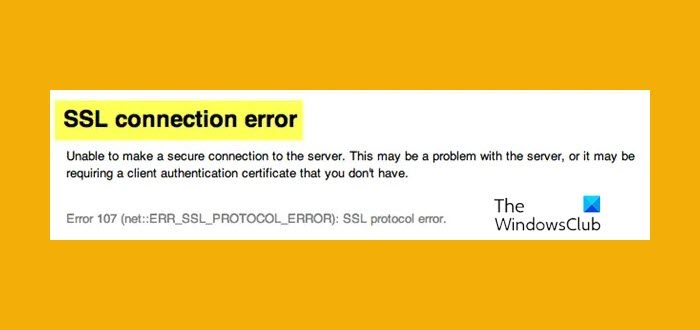An SSL connection error is a very common one, and if you receive any of these common SSL Connection errors in Chrome, Edge, or Firefox, follow these solutions to resolve the issue. Many a time, the issue can only be rectified by the website, but in some cases, the error could be because of some misconfiguration on your Windows 10 PC. Browsers come with a feature that checks for SSL errors by parsing the certificates, and that’s why we receive these errors. In this post, we will offer solutions to fix common SSL Connection errors that you receive in the browsers.

Here is a list of common SSL Connection errors
- The connection is not private with ERR_CERT_COMMON_NAME_INVALID
- Your connection is not private with NET::ERR_CERT_AUTHORITY_INVALID
- The clock is behind or Your clock is ahead or Net::ERR_CERT_DATE_INVALID
- This webpage is not available or ERR_SSL_VERSION_OR_CIPHER_MISMATCH
- This webpage has a redirect loop or ERR_TOO_MANY_REDIRECTS
- The server has a weak ephemeral Diffie-Hellman public key or ERR_SSL_WEAK_EPHEMERAL_DH_KEY
While we have linked to solutions in the list above, let’s talk about the last two on the list.
Fix Common SSL Connection errors
This webpage has a redirect loop or ERR_TOO_MANY_REDIRECTS
The reason you receive this ERR_TOO_MANY_REDIRECTS error is that the website is trying to redirect you to the right page, but is stuck in an infinite redirection loop. When the browser doesn’t receive anything from the server for a long time, it puts up redirects error.
There are two parts to this. The first is on the consumer side, while the other is on the server-side. If you are a consumer, the only option here is to clear your browser’s cookies. Instead of clearing all of them, you can delete cookies of that specific website for which you receive this error.
If you own the website where this issue has occurred, you can try clearing the cache/third-party cache services of your WordPress site, on the server, reset any third-party proxy services and so on. Your administrator will be able to help you with it. You should also check with the HTTPS redirect rules on your server to find any misconfiguration.
The server has a weak ephemeral Diffie-Hellman public key or ERR_SSL_WEAK_EPHEMERAL_DH_KEY
This is a server-only problem which the website owner needs to fix. ERR_SSL_WEAK_EPHEMERAL_DH_KEY means that the server is trying to set up a secure connection but, due to disastrous misconfiguration, the connections would not be secure at all. In simpler words, the website is using an outdated SSL security code.
- Update your server to support ECDHE (Elliptic Curve Diffie-Hellman)
- Turn off DHE (Ephemeral Diffie-Hellman).
In case ECDHE is unavailable, turn off all DHE cipher suites and use RSA.
Let us know if these solutions helped.
Leave a Reply